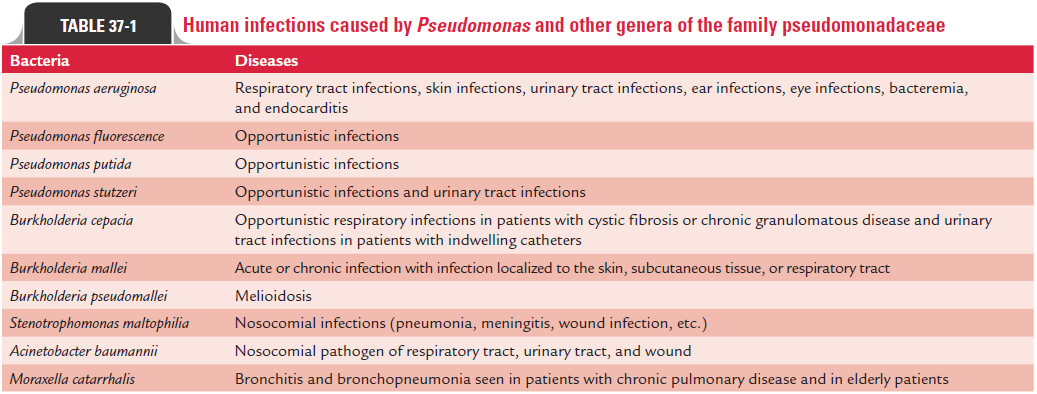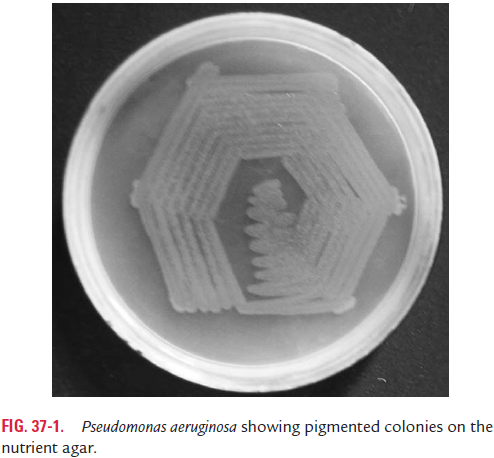Chapter: Microbiology and Immunology: Bacteriology: Pseudomonas, Burkholderia, and Moraxell
Pseudomonas aeruginosa: Properties of the Bacteria
Pseudomonas aeruginosa
P. aeruginosa is the most important species associated withhuman infection. It is a most common human saprophyte, but it rarely causes disease in healthy individuals. P. aeruginosa causes most of human infections in immunocompromised human host.
Properties of the Bacteria
◗ Morphology
P. aeruginosa shows the following morphological features:
· P. aeruginosa is a straight or slightly curved, Gram-negativebacillus measuring 0.5–1.0 3 1.5–5.0 mm in size arranged singly, in pairs, or in short chains.
· It is motile by the presence of a polar flagellum. Occasion-ally, strains may possess two or three polar flagella.
· Pseudomonas spp. is noncapsulated. Although the bacteria arenoncapsulated, many strains appear mucoid by production of an abundant of extracellular polysaccharide composed of alginate polymers. This slime layer forms a loose capsule or glycocalyx around the bacillus. These strains are particularly isolated from patients with cystic fibrosis.
· Pseudomonas spp. is nonsporing and fimbriated.
◗ Culture
Pseudomonas spp. are strictly aerobic bacteria. P. aeruginosa growsover a wide range of temperatures (5–32°C), the optimum tem-perature being 37°C. P. aeruginosa grows on commonly used routine media including nutrient agar, blood agar, MacConkey agar, and deoxycholate citrate agar (DCA).
1. Nutrient agar: P. aeruginosaafter incubation for 24 hoursat 37°C on nutrient agar produces large (2–3 mm in diam-eter), opaque, translucent, and irregularly round colonies. These colonies emit a characteristic musty to fruity odor due to production of aminoacetophenone from the amino acid tryptophan. It produces hemolytic colonies on blood agar.
2. MacConkey agar: The organism produces colorless non–lactose-fermenting colonies on MacConkey media.
3. Cetrimide agar: Cetrimide agar is a selective medium forculture of P. aeruginosa.
4. Nutrient broth: In nutrient broth, it produces a denseturbidity with surface pellicle.
aeruginosa produces different types of pigments, such as (a)pyocyanin, (b) pyoverdin, (c) pyorubin, and (d) pyomelanin. However, some strains of Pseudomonas are not pigmented.
· Pyocyanin is specifically produced byP. aeruginosa,whichdiffuses into the surrounding medium (Fig. 37-1). The pigment is soluble in chloroform and water.

· Pyoverdin, or fluorescein, is produced byP. aeruginosaas well as by many other Pseudomonas species. These pigments give a yellow tinge to the colonies of bacteria and are best demonstrated in microscope using ultravi-olet source of light. Fluorescein is soluble in water, but insoluble in chloroform.
· Pyorubin is a red pigment, which is soluble in water butinsoluble in alcohol.
· Pyomelanin is a brown pigment.
◗ Biochemical reactions
· They are oxidase positive. Oxidase test is an important test for identification of P. aeruginosa. All the strains are oxidase positive within 30 seconds of performing the test.
· They are nonfermentative bacteria. They utilize sugars by an oxidase metabolism, with oxygen as the termi-nal electron acceptor. Special media, such as oxidation-fermentation (OF) media, are used to demonstrate the low quantity of acid produced during oxidative breakdown of sugars. P. aeruginosa utilizes glucose, forming acid only (Color Photo 38).
· They do not utilize lactose and maltose.
· They reduce nitrates to nitrite, which is further broken down to gaseous nitrogens.
· They are catalase positive.
· They are arginine dihydrolase positive.
· They are indole, MR, VP, and H2S negative.

◗ Other properties
Susceptibility to physical and chemicals agents: P. aeruginosais heat-labile bacterium, readily killed at 55°C in 1 hour. It is also highly susceptible to acid, silver salts, 2% alkaline, glutaralde-hyde, and disinfectants (such as Dettol and cetrimide). However, P. aeruginosa is very strongly resistant to common antisepticsand disinfectants, such as chloroxylenol, hexachlorophene, and quaternary ammonium compounds
Related Topics